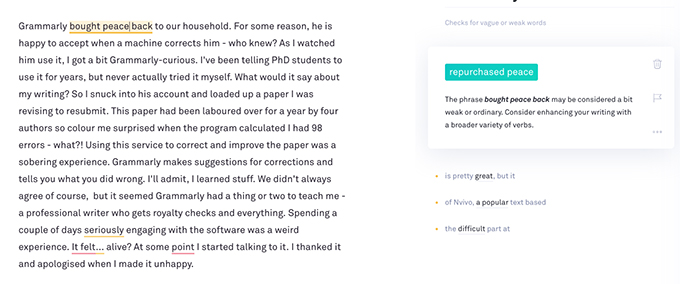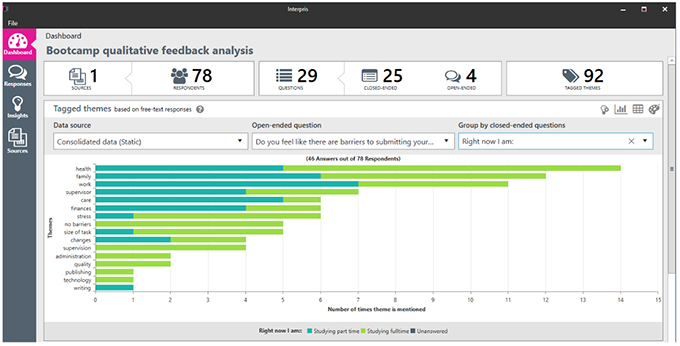
As a researcher, it can be tempting to ignore the current hysteria about automation. I’ve had a bit of a “not my circus, not my monkeys” attitude myself. Perhaps whole industries will disappear, our taxis will become self driving and our fast food outlets staffed by robots, but research work? I like to think research takes genuinely human talents of creativity, curiosity, wisdom and even empathy and emotion (as much as we don’t like to admit it). To replace our work with machines will be difficult, expensive and time consuming
… or will it?
I don’t want to be an alarmist, but I’ve had a few experiences over the last couple of weeks that have left me wondering about what the future holds.
Let’s start with writing. Thesis Whisperer Jnr is at the pointy end of his secondary school journey and is doing his ATAR subjects (the Australian equivalent of ‘A levels’ or SATs) and has to write a lot of essays for English and Economics. He knows what I do for a living, but for some reason, he resents my insistence on the correct use of apostrophes and modal verbs, so he leaves me out of the writing process. However, when an assignment is due, I am always called on for a last minute copy edit. His content is good, but hella messy. When I try to explain where he went wrong, we argue. By the end of an essay, we are both frazzled, and I don’t feel a lot of learning has occurred. My sister, Anitra, suggested I buy Grammarly, which she used to re-teach herself grammar when she was doing her Masters degree, so I bought him a subscription.
Grammarly brought peace back to our household. For some reason, Thesis Whisperer Jnr is happy for a machine to correct him instead of a parent (who knew?!). As I watched him use it, I’ll admit, I got a bit Grammarly-curious. What would it say about my writing? So I snuck into his account and loaded up a paper I was revising to resubmit. This paper had been laboured over for nearly a year by four authors. Colour me surprised when the program calculated I had 98 errors – what?! I rolled up my sleeves and started correcting.
Grammarly highlights your mistakes, makes suggestions for corrections and tells you what you did wrong. I’ll admit, I learned stuff. Spending a couple of days engaging with the software to improve this piece of writing was a weird experience. It felt… alive? At some point, I started talking to it. I thanked it a few times and apologised when I appeared to make it unhappy. Like any pair of writers, we didn’t always agree on matters of style. The image below is where I have used Grammarly to write the previous paragraph of this post:

Grammarly is an excellent example of a new ‘human in the loop’ method of working. I think this paper ended up being one of the best I have ever written. With machine assistance, I became a ‘writing cyborg’ – better than a mere human. A lot of people I talked to online seemed a bit disturbed at the idea of becoming a writing cyborg, some were outright dismissive of Grammarly’s value, but I like it and have decided to keep using it. Much of my writing is public and I should make some attempt to be well-dressed.
I was still musing on this experience when I encountered my next ‘human in the loop’ opportunity. One of the perks of being a prolific blogger is the loot. I’m not going to lie – getting free stuff is pretty great, but it does sometimes come with the expectation that you will promote the products. In the past, I have been given complimentary copies of Nvivo, a popular text-based analysis software. The latest versions are machine learning enabled – but I do research work with machine learning scientists, so I haven’t bothered exploring this capability.
Despite getting a freebie, I haven’t spruiked it here because I strive to appeal to all disciplines and Nvivo is a qualitative researcher’s tool. Besides – and I say this with love – Nvivo is kind of hard to use. It’s a powerful beast, but complicated, with a steep learning curve. Over the years I have developed a bit of relationship with the Nvivo sales team, who ring me up now and then to do customer validation work. I complained to them multiple times about the complexity of the product, and they said they were working on it. A couple of weeks ago, several members of QSR international, the company who makes Nvivo, came to visit me to show me the fruits of this labour – a new product called ‘Interpris’. I could barely contain my excitement when I saw what Interpris could do.
For those of you who are not familiar with the qualitative research, text-based coding techniques are used to analyse transcripts of interviews and open-ended questions in surveys (coding methods are outlined brilliantly in Johnny Saldana’s Qualitative Coding Manual). Most of the work – the tricky part at least – is coming up with themes to apply to the text. Theme generation is where the ‘human magic’ lies. The process is immersive; a matter of reading the text over and over, thinking and imagining what it can mean, then highlighting the relevant part of the text where the themes occur. Interpris can, apparently, generate themes automatically.
Since Interpris is PC only at the moment, and I am a Mac girl, Mr Thesis Whisperer had to set up an old PC for me to try it out. The tech support piece was significant – Mr Thesis Whisperer was like this for a long time:

As it turned out, the set up took much longer than the analysis work. I deliberately fed it a complicated excel file, expecting the software to choke, but it swallowed the sheet without missing a beat. It was weird watching a progress bar say ‘analyse’ themes’, rather than do it myself. When the results popped on the screen, I gasped. At first glance, the results looked utterly plausible.
At this point, I actually had to get up and go for a walk to get some air. I don’t exagerrate when I say Interpris had done in less than a minute what would take me at least a day – maybe two. In fact, I had been putting off doing this particular bit of analysis because I knew it would take ages and I’ve been busy dealing with an increased teaching load. I honestly didn’t expect the software to get anywhere near a human effort with no input at all. I panicked for a moment, wondering if machines were REALLY coming for my job.
After I had calmed down, I went back and looked more carefully at the analysis – and breathed out. Interpris hasn’t stolen my job – yet. It had noticed all the essential themes in the data (sobering), but it also pulled out unimportant stuff. I needed to do some ‘gardening work’ to shape the results the way I wanted to, but this process was straightforward. The product is user-friendly and makes nice, clean looking graphs. Here’s one I made about the barriers to completion faced by our Thesis Bootcamp participants:

In my view, QSR is definitely on the right track with this product. Interpris strips back all the complexity of Nvivo and makes the machine learning capability the centrepiece of the user experience.I completed an analysis that would probably have taken me two days in just 47 minutes. With time savings like that, QSR can justify the hefty price tag of $1500 per year, especially for government clients. While it’s true that Interpris can’t do the really sophisticated forms of text-based analysis (yet?), my experience suggests that for open-ended questions in survey data it works just fine. Just like with Grammarly, sometimes we disagreed on style, but Interpris makes me into an incredibly efficient researcher-cyborg.
The QSR team told me that “university researchers had not shown much interest” in Interpris, which is why they aimed it squarely at government clients. I find this attitude from the qualitative research community disappointing. I’ve noticed that there can be a certain strain of purism in some disciplines, like anthropology and sociology, who turn their nose up at tools that make research easier. I’ve had PhD students at ANU say using software to help do analysis is “cheating” and I know this attitude comes from more senior members of staff. In my view, privileging of ‘artisanal’ approaches is sticking our collective heads in the sand.
While the machines are not coming for our jobs soon, in my view the smart researcher looks for opportunities to collaborate with them – now. We have a role in shaping what these machines become and being afraid of what might happen is not going to change the fact that parts of our jobs that we hold dear will become automated. I graduated architecture school on the crest of the digital wave in the mid-1990s and watched older architects struggle to adapt to drawing programs. Those who didn’t adapt ended up out of work pretty quickly.
I fear that is what is going to happen to researchers who do not jump on the machine-assisted bandwagon. What do you think?
